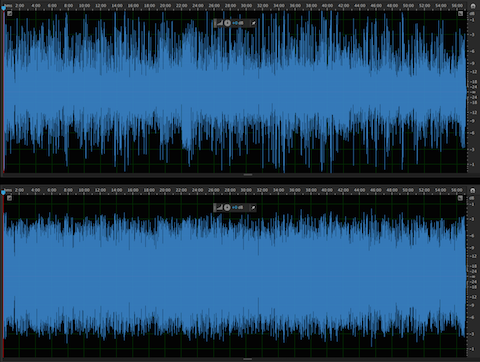I recently analyzed a few of the internal Podcasts produced by CNN. One particular installment is yet another example of a major media outlet distributing audio that is in my view unsuitable for this particular platform.
Let’s discuss file attributes and measured specs. for one of CNN’s distributed Podcasts:
The distributed audio is mono, 64kbps, with music elements. I’ve stated how I feel about this. I’m not a proponent of 64 kbps MP3 audio PERIOD (mono or stereo). In general audio in this format sounds horrible. Feel free to disagree.
Secondly, the Integrated (Program) Loudness for this particular program is just about -23.0 LUFS with a Maximum True Peak of +0.40 dBTP. From my perspective the perceptual Loudness misses the mark. And, the audio is clipped.
Lastly, the produced audio is way too dynamic for spoken word. The perceptual inconsistency of the delivery by the participants is inadequate when considering how (for the most part) this program will be consumed (mobile devices, problematic ambient spaces, etc.).
I decided to sort of showcase this particular program because it is a good candidate for flexible Target considerations. What do I mean by “flexible Target considerations?” Let me explain …
Again, the distributed file is mono. The recommended Integrated Loudness Target for mono Podcasts is -19.0 LUFS. This is the perceptual equivalent of -16.0 LUFS stereo. If I were to apply a +4 db gain offset to Loudness Normalize this audio to -19.0 LUFS, there would be very little change in the original dynamic structure of the audio. However without some form of aggressive limiting, the maximum amplitude or Peak Ceiling would be driven into oblivion. In fact audible distortion may occur with or without limiting. This is obviously not recommended.
There are two options to consider: 1) apply Dynamic Range Compression before Loudness Normalization, or 2) shoot for a lower Integrated Loudness target. For this particular example I chose to implement both options.
First, in my view optimizing the dynamics in this program for Podcast distribution is unavoidable. It’s just way too choppy and it lacks delivery consistency for spoken word. Also, by lowering the L.Normalized Target, the necessary added gain offset will be reduced resulting in less aggressive limiting. In addition, the reduced amount of added gain will curtail noise floor elevation and other variables such as exaggerated breaths.
As noted the distributed Podcast (displayed in the attached upper waveform example) checks in at -23.0 LUFS and it is clipped. My optimized version (displayed in the lower waveform example) checks in at -20.2 LUFS with a Maximum True Peak of -1.23 dBTP. It is well within a reasonable level of Program Loudness tolerance for Podcast L.Normalization. In fact the perceptual difference between the processed -20.0 LUFS audio and a -19.0 LUFS version would be pretty much undetectable. In essence the audio has been optimized and it exhibits improved intelligibility. It is now well suited for Podcast distribution.
(If you are interested in the tools that I use, they are listed under Available Services).
It is no secret that I am a staunch proponent of the -16.0 LUFS/-19.0 LUFS recommendations for Podcasts. However, in certain situations – tolerance for slightly reduced Program Loudness Targets is acceptable.
For the record – my remaster is much easier to listen to. CNN can do better.
-paul.

Any comment on the fact that CNN appears to broadcast all programmes in mono as well?
Hi,
I’m not a proponent of mono Podcasts. My issue is most, if not all Podcasts contain music mastered in stereo. Plus – music in general sounds horrid at 64kbps, which is the common bit rate used for mono distribution. Many people feel in most cases the fidelity of the music is irrelevant due to the nature of shortened Intro’s and Beds. I totally disagree. Bottom line: The mono approach is common for those who feel it is more economical with regards to file sizes and bandwidth. In this day and age that’s a frivolous perspective IMHO.
-paul.